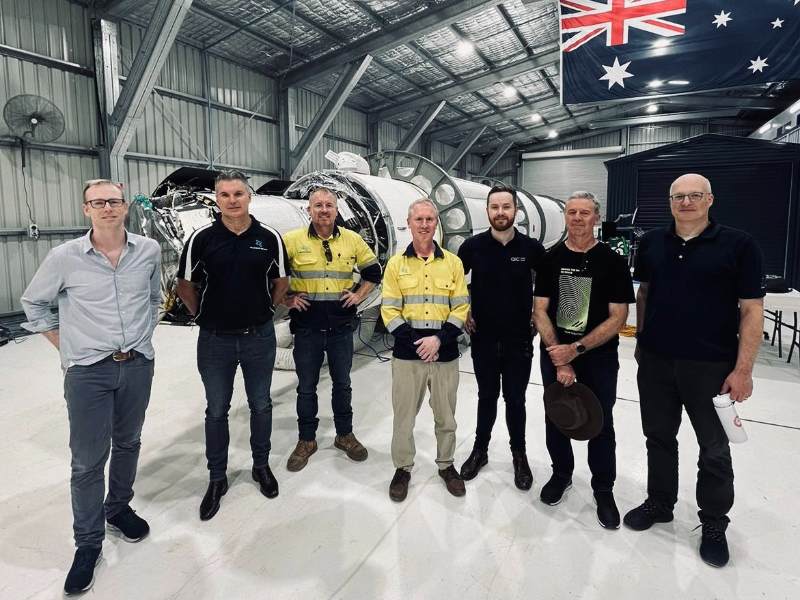Gilmour Space Technologies expects to lift its Eris rocket to its vertical position on the launchpad for the first time in the next ten days as the company quietly moves the three-stage launch vehicle toward its first test flight in the coming weeks.
Gilmour director of communications Michelle Gilmour told InnovationAus.com the company continued to make steady, methodical progress toward launch. The company expects to nominate a target launch date and broader launch window within the next two weeks.
The timing of the launch is still dependent of the company being granted its launch permit from the Australian Space Agency, the final piece of regulatory paperwork required before the rocket can get off the ground.
The Gilmour Space board of directors met at the company’s Bowen Orbital Spaceport a week ago, getting a look at the fully integrated Eris vehicle for the first time. The board visitors included Blackbird’s Rick Baker, Main Sequence’ Martin Duursma, and Brett Rome, US-based Fine Structure Ventures’ Brett Rome and Queensland Investment Corporation’s Patrick Christiansen.
Blackbird, Main Sequence, Fine Structure and QIC led Gilmour Space’s Series A, Series B, Series C and Series D investment rounds respectively.

The company’s Bowen Orbital Spaceport was granted it launch facilities licence three weeks ago, a huge step forward toward a first launch day. And while Michelle Gilmour is “hopeful” that the company will get a launch permit for the Eris test flight in the next two weeks, she says its in the hands of the Space Agency.
“We’ve done a lot of work on it. We’ve submitted more than 15,000 pages of documentation to the agency already,” Ms Gilmour said. “That [permit] is the last tick in the box that we need before we launch from the regulatory point of view.”
“I would expect that we will be able to knuckle down [and announce] our launch date in the next one or two weeks. This is obviously still pending the launch permit approval but expect to be able to nominate a date when we will be ready to launch,” she said.
Putting the rocket into its vertical position for the first time is the next big milestone, as it enables a period of critical testing of the vehicle.
The work and testing on the transporter-erector – which takes the 30-tonne rocket from its vehicle assembly building to the pad and lifts it into its vertical position – is largely complete.
“We got the transporter erector vertical, and we have shared some video on that. We’re doing more tests on the grabbing and releasing mechanisms as well.”
The world is racing to space (and beyond)… and we can’t wait to join them from Queensland, Australia!🚀🇦🇺 #Flashback to when we got our Transporter Erector vertical at the Bowen Orbital Spaceport. #BridgingCountrytoSky #ErisTestflight1 #BOS pic.twitter.com/P7ICIkEHo6
— Gilmour Space (@GilmourSpace) March 15, 2024
“We haven’t got the rocket vertical yet, but that’s going to be in the next two weeks. We are doing our work in sprints and we’re taking a short break before our next sprint, which starts next week.
“That’s when we’re going to get the rocket vertical on the transporter erector, which is a ‘dry’ dress rehearsal, and then our ‘wet’ dress rehearsal. And before long, we’ll be ready for launch.
As the name suggests, the ‘wet’ testing of the vehicle involves loading its liquid fuels and oxides as part of a full rehearsal. On completion of the ‘wet’ testing, fuels are off-loaded and – and assuming the rehearsals had been successful – a launch target launch date can be nominated.
Confidence is running high that the launch date in April, for the first orbital rocket designed and manufactured in Australia.
In the meantime, Gilmour Space is on the move on the Gold Coast, consolidating three factory/office and storage spaces into a single headquarters facility.
The move includes the relocation of significant plant and equipment will take place over the coming months with the company expecting to have everyone in the new 10,000 square metre Yatala facility at the back end of May.
“Obviously moving is not something that can happen overnight. The moving itself started happening over the last couple of weeks,” Michelle Gilmour said.
“We were a small company, and we grew quickly, so we just grabbed whatever space was available, some nearby or some not so nearby, she said. But with federal support through the Australian Space Manufacturing Network Grant that the company won through the Modern Manufacturing Initiative, and with state and local government involvement, Gilmour has been able to consolidate under a single roof.
“But we also have to balance the move out with the fact that we have a launch coming up. So there really is a lot on right now.
Do you know more? Contact James Riley via Email.

